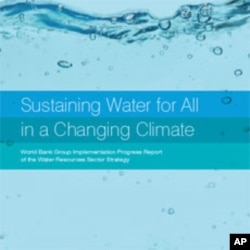A soaring world population, climate change and greater demands for food are placing greater demands on the planet’s water resources. The World Bank says the best way to address those issues is to have better information and a more integrated approach to water management.
The bank says a review of its 2003 water resources strategy finds many successes in water projects. But it also sets priorities and makes recommendations as access to water becomes critical for many people around the world.
Life and death
“As every high school child knows, water runs through absolutely every we do,” says World Bank Water Sector Manager Julia Bucknall. “We can’t grow any food without water. We can’t live without water. We can’t run our cities without managing our water properly.”
The floods in Pakistan, she says, show the importance of having a good water management policy in place.
“Both from the resource point of view, in the sense of the floods, but also from the basic management of water supply and sanitation. That’s what is going to be killing a lot of people now after the immediate impact of the floods,” she says.
Strategy plan
In 2003, the World Bank issued a strategic plan for water projects. In a new report, called Sustaining Water for All in a Changing Climate, the bank reviewed that strategy.
“The strategy itself,” says Bucknall,” was quite a path-breaking strategy, which really put infrastructure to the front and center of the development agenda and anticipated many of the issues…population growth, climate change and the need to manage water for food.”
She says the strategy has resulted in “enormous success.”
“We have been able to triple our lending in the water sector. And we’ve been able to be much more integrated so that we look at building irrigation systems, for example, at the same time as looking at the water resources that those systems depend on,” she says, adding, “We are very pleased with the results.”
Making water a priority
At recent climate change conferences, advocates for water management tried to put the issue high on the agenda but were not always successful.
Bucknall says, “Everybody knows it’s a priority in some very generic sense. I think what people don’t always do is take the very hard choices that have to be made in order to manage water properly.”
In making those tough choices, the World Bank official says some people will face “disruptions.”
“Many governments are just not willing to take that decision now and sort of put it off until it becomes a crisis later. They don’t actively put it off until it becomes a crisis later, but that’s what ends up happening.”
What next?
The review makes a number of recommendations. “One is to continue efforts to integrate water resources with water services. So, this is something we’ve done quite well over the past five or six years, but we want to do it more and more consistently,” she says.
Other recommendations include putting water management higher on the climate change agenda and increase efforts to improve sanitation.
“One third of the world’s population does not have access to a toilet, which has huge social and health implications,” she says, “You know more people die of diarrhea than of AIDS, malaria and TB combined.”
The review also calls for support for hydro power, calling it “the largest source of renewable and low carbon energy, including high-risk, high-reward infrastructure projects.” But Bucknall admits it’s a complicated issue.
Dams, for instance, have been criticized by some as harmful to the environment and the livelihoods of those living near lakes and resources.
Bucknall says hydropower could mean building damns but also could mean making better use of existing dams or rehabilitating them.
“Sometimes making better use out of them so that you can use them for adaptation to climate change,’ she says, “And also to give more space for the environment. One of the things we’re looking at actively is reengineering existing dams to make them have more multiple uses for people, for energy and for the environment.”
Inger Andersen, vice-president for sustainable development at the World Bank, says, “Only 23 percent of hydropower potential located in developing countries has been exploited. The gains for the poor can be enormous.”






